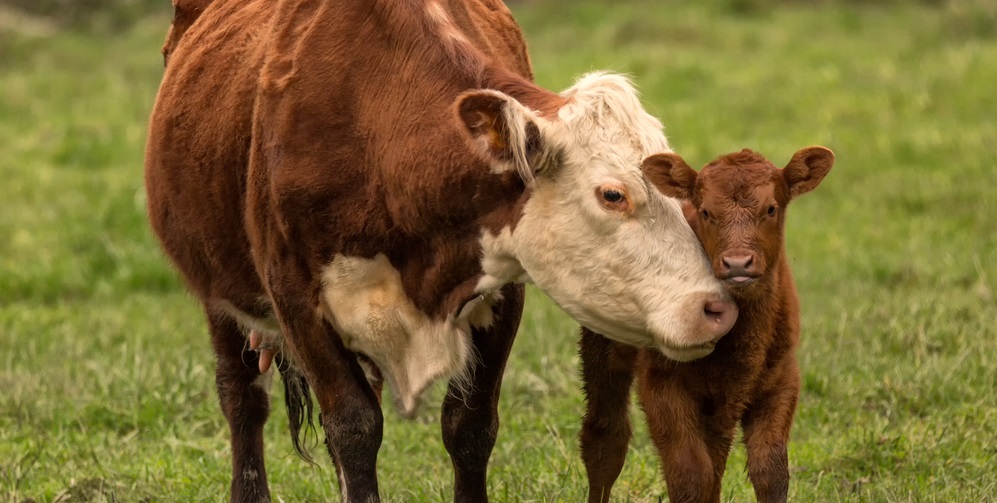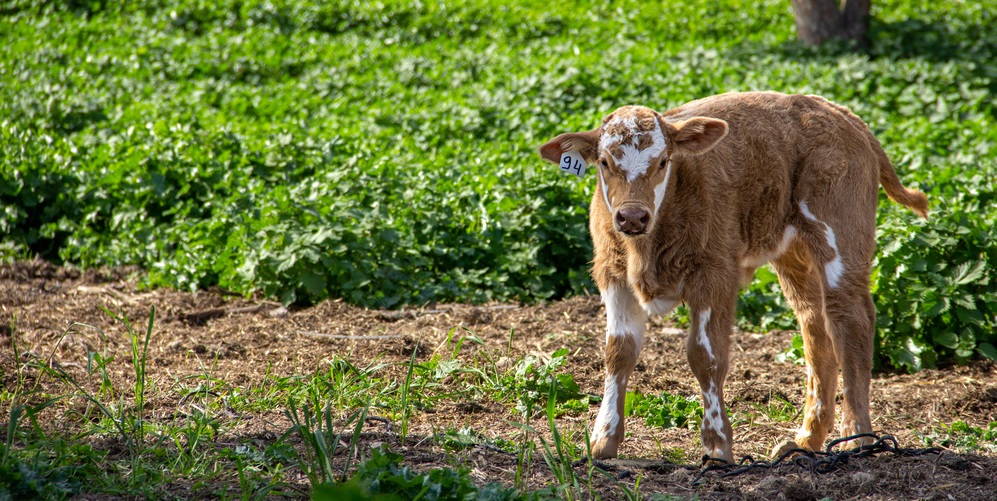If you’ve ever bred cattle, you may have experienced the unfortunate circumstance of a navel infection in your newborn calves. Without proper prevention, navel infections, or omphalophlebitis, can develop into a chronic disease that results in a grueling treatment process.
Fortunately, you can prevent incidences by practicing good hygiene and utilizing navel dipping after birth. To fully understand the prevention process, let’s break down:
- What is a navel infection
- What causes a navel infection
- Four best practices of prevention
- Signs of a navel infection
- How to treat navel infections
What Is a Navel Infection?
In unborn calves, the navel cord, more commonly known as the umbilical cord (which will eventually become the belly button) is a hollow tube in the belly that provides direct access to the abdominal cavity and liver. After birth, the navel cavity remains wet for several days, becoming an easy entrance for bacteria and the perfect breeding ground for a bacterial infection to develop.
Escherichia coli (E. coli) is a common cause of navel infections. These infections can result in adverse health outcomes, including:
- Peritonitis – This refers to an infection within the abdominal cavity itself.
- Arthritis – Abscesses inside the joints can cause arthritis, even in young calves.
- Meningitis – This refers to an infection of the central nervous system.
Once bacteria enters the navel, the umbilical infection can spread to nearby body parts. Left untreated, the E. coli bacteria can reach the bloodstream, causing septicemia, a potentially fatal disease.
What Causes a Navel Infection?
There are many causes of navel infections, the most common include:
- Poor Hygiene – Exposure to dirty calving areas or repeated touching of the navel during weighing can increase the risk of infection.
- Weak Calves – Weak calves are more susceptible to developing navel infections. This can be due to prolonged calving or a malnourished mother.
- Inadequate Colostral Intake – Colostral is a fluid secreted by the mammary gland before and after birth. Calves need between 1.5–2 liters within eight hours after their birth.
- Difficult Births – When calves are born backward or through a cesarean section (c-section), the navel can be cut short. Short navels predispose calves to navel infections.
Four Best Practices to Prevent a Navel Infection
To negate navel infections and ensure healthy calves and livestock that can grow to their full potential, consider these preventative measures:
- Ensure Proper Hygiene – Proper hygiene before, during, and after birth is critical to preventing navel infections. To that end, here are a few birthing hygiene tips:
- Replace wood chips with clean bedding and straw
- Disinfect the calving area and instruments, including calf pullers, chains, and slings
- Wear disposable latex or nitrile gloves during the birthing process
- Invest in walk-on scales to reduce contact and potential contamination of the navel
- Implement Strict Bull-Vetting Criteria – Months prior to the birthing process is the mating process, where bull selection is critical. With extensive vetting criteria, you can ensure you choose healthy bulls, increasing the likelihood of healthy calves and lowering the risk of navel infection.
- Seek Professional Assistance For Difficult Births – Once contractions are evident, the calf should be delivered within the next two hours. While some choose for this process to occur naturally, it’s important to be ready to step in and provide assistance should it be needed. Backward deliveries and other complications will require the help of a professional.
- Utilize Navel Dip – Navel dipping is among the most popular prevention measure for navel infection. However, harsh disinfectants like iodine can cause unwanted inflammation. Luckily, there are now iodine-free navel dip options like the Super 7 Ultra Navel Dip from Innovacyn that speed up the drying process and protect the navel. A clinical study through Auburn University found that compared to traditional iodine solutions, the Super 7 Navel Dip offered faster dry-down times, lower costs, no irritation, and no infections within the 100 female neonatal calves studied.
Prevention is critical to keeping your newborn livestock healthy and happy. But what happens if you don’t catch the bacterial infection soon enough? How do you treat navel infections, and more importantly, how can you tell if they occur in the first place?
Signs of a Navel Infection
If you suspect a navel infection has occurred, or complications during the birthing process could have resulted in bacteria entering the navel cavity, stay vigilant when the calf is about three weeks old. Navel infection symptoms typically appear around this time.
Signs of a navel infection include joints that are:
- Hot
- Swollen
- Producing pus
- Experiencing pain
How to Treat a Navel Infection
The standard treatment protocol is a week-long course of penicillin. However, if the calf is suffering from meningitis and polyarthritis due to septicemia, your veterinarian may prescribe additional antibiotics. If abscesses are present, they should be lanced and flushed daily for the next three to five days.
The infection may still be present after both the pain and fever have dissipated. To that end, it’s crucial to follow through with the full course of treatment and not to discontinue prematurely, even if the calf shows improvement.
In severe cases, where the infection spreads to the bladder or liver, surgery might be necessary to remove the infected stalk. Even after the infection disappears, the navel may remain enlarged and hard.
Prevent Navel Infections with Vetericyn
Not only are navel infections debilitating for the animal, but treatment options can also be emotionally and financially taxing. By prioritizing livestock care, such as proper hygiene, professional assistance, and iodine-free navel dips, you can avoid these adverse outcomes altogether.
Here at Vetericyn, we care as much about your livestock as you do. That’s why we offer a range of animal wellness products, including the Vetericyn Super 7 Ultra Navel Care. Backed by clinical studies, this navel dip is an effective, safe, and pain-free salve to ease your navel infection worries. For cutting-edge animal care products and healthy livestock, choose Vetericyn.
The health of your livestock is our number one priority. Check out our Blog on Vetericyn to learn more about pink eye in cows and other infections your livestock may be exposed to. From chicken wound care to teat dipping, we’re here to address any livestock concerns!
Sources:
- Washington State University. Preventing Navel Ill. https://extension.wsu.edu/animalag/content/preventing-navel-ill/
- Alberta Farmer Express. Navel Infection Prevention and Treatment. https://www.albertafarmexpress.ca/livestock/navel-infection-prevention-and-treatment/
- The Free Dictionary. Colostrum. https://medical-dictionary.thefreedictionary.com/colostral
- NADIS. Navel ill (Omphalitis/Omphaloplebitis). https://www.nadis.org.uk/disease-a-z/cattle/joint-ill-navel-ill-of-calves/#:~:text=an%20umbilical%20abscess.-,Treatment,meningitis%20and%20polyarthritis%20following%20septicaemia.
- Vetericyn. New Super 7+ Navel Dip from Innovacyn Speeds Dry Down Time. https://vetericyn.com/blog/new-super-7-navel-dip-from-innovacyn-speeds-dry-down-time/
- American Association of Bovine Practitioners Proceedings of the Annual Conference. Clinical evaluation of Vetericyn Plus™ Pinkeye Spray as an aid in reduction of pain and infection in calves with experimentally induced infectious bovine keratoconjunctivitis. https://journals.tdl.org/bovine/index.php/AABP/article/view/3542

